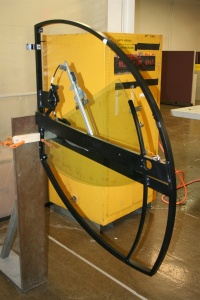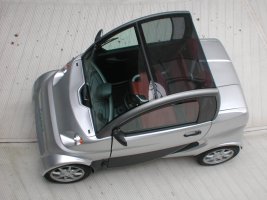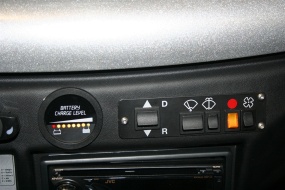Click on the photo of AEV President Scott Thornton and the Kurrent for a high-res gallery of photos from our visit to the AEV factory
Mix an old non-descript suburban Detroit warehouse with some new Ikea furniture and fixtures, throw in some entrepreneurs with extensive auto industry experience and a plan to attack an environmentally conscious market niche and you have American Electric Vehicles (AEV). AEV President Scott Thornton invited AutoblogGreen to visit their factory in Ferndale, MI to see their production process and drive their first product, the Kurrent neighborhood electric vehicle.
ABG talked to Scott in late December about his company, the Kurrent, but this was the first opportunity to see this Italian-designed NEV in person. The Ferndale warehouse serves as headquarters, engineering facility, parts warehouse and assembly plant for AEV. Most of the staff are auto industry veterans, including Thornton who has 27 years in the business, much of it with Jeep. Right now, apart from the office areas, the build is divided into two main areas, with one being used for parts storage and the other for assembly and testing. As production ramps up through this year, the parts storage area will be switched over to a second assembly area. Continue reading about the assembly process and driving impressions after the jump.
Mix an old non-descript suburban Detroit warehouse with some new Ikea furniture and fixtures, throw in some entrepreneurs with extensive auto industry experience and a plan to attack an environmentally conscious market niche and you have American Electric Vehicles (AEV). AEV President Scott Thornton invited AutoblogGreen to visit their factory in Ferndale, MI to see their production process and drive their first product, the Kurrent neighborhood electric vehicle.
ABG talked to Scott in late December about his company, the Kurrent, but this was the first opportunity to see this Italian-designed NEV in person. The Ferndale warehouse serves as headquarters, engineering facility, parts warehouse and assembly plant for AEV. Most of the staff are auto industry veterans, including Thornton who has 27 years in the business, much of it with Jeep. Right now, apart from the office areas, the build is divided into two main areas, with one being used for parts storage and the other for assembly and testing. As production ramps up through this year, the parts storage area will be switched over to a second assembly area. Continue reading about the assembly process and driving impressions after the jump.
Click to watch a short video the assembly process for the Kurrent NEV
Due to the relative simplicity of the Kurrent, the assembly area has no moving line, but uses a cellular process instead. The major components like the body panels and the frame are produced by suppliers off-site and delivered to the AEV facility ready for assembly. The mechanical components are all off the shelf parts such as the front shock absorbers which are sourced from Ducati motorcycles, all of which helps to keep the overall costs of the Kurrent to a minimum. The ABS body panels have the color molded in, so no painting is required. The aluminum "egg-shell" tube frame also comes into the plant painted, and is exposed to view in many areas of the vehicle. Check out the video for nice overview from Scott of the whole assembly process.

After seeing the assembly process, we went for a test drive in a Kurrent. The Kurrent is far more than your average golf cart, but it certainly isn't a car for everyone. The thirty-five mph top speed means that drivers aren't going anywhere near a highway. On the other hand if you live in a gated community or work on some kind of campus, this could be a very economical way to get around. It could also work in smaller to medium sized cities like Ann Arbor, MI or Madison, WI. If you live in the city not too far from the downtown area, it makes a very efficient, clean way to go to a class, work, or grocery store. Speaking of the latter, the Kurrent has a real locking trunk that easily hold three or four bags of groceries.

Given the 4.1 kW motor, acceleration is leisurely, particularly with people aboard. Lifting off the go pedal reveals fairly aggressive regenerative braking to maximize the battery range. Speaking of range, it maxes out at about 40 miles, but is reduced depending on your driving habits, use of the headlights, radio, etc.

This is certainly not a car for everyone, but if you fit the profile, it definitely feels like a very reasonable choice. It's cheaper than a GEM and much better equipped. Styling is always a matter of taste, but the Kurrent has plenty of character for such a small car, and it's definitely better than your average golf cart. If a neighborhood electric vehicle meets your needs, the Kurrent is definitely worth checking out.
Related:



Sign in to post
Please sign in to leave a comment.
Continue